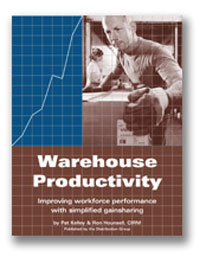| Ask Employees How they Should be Measured: Not sure in some areas what metric should be used for the gainshare? Go to the source.
“Every time we have tried this approach, the blue collar people in the jobs have unfailingly told us how to measure their own productivity,” Kelley and Hounsell say.
Establish Quality Qualifiers: Clearly, raw productivity gains are self-defeating if they come at the price of a decline in quality and accuracy. So, “quality qualifiers” need to be added for the gainshare payments to take effect.
Where should they be set? At the same level that you have your disciplinary standard set for unacceptable quality.
While some may think the standard should be higher, Kelley and Hounsell disagree.
“Set the quality qualifier at a low enough level where it doesn’t leave any reasonable worker out of achieving a gainshare raise, but not so low you would create problems for yourself,” they say.
 Keep It Simple: Everyone – employees, supervisors, managers – must be able to easily understand the program and explain how it works. Keep It Simple: Everyone – employees, supervisors, managers – must be able to easily understand the program and explain how it works.
“More gainsharing programs have crashed and burned due to complexity than any other single reason,” Kelley and Hounsell believe.
If an employee can explain it like this: “Let me get this straight – if I hit in at 25% above standard for a month, you’ll pay me an additional dollar per hour for every hour I work the following month?” – you have the basis for a very successful plan.
Establishing “Buyouts”: A facility cannot stand still. Overall productivity improvements are made, equipment or software is deployed, etc. Sometimes, the standards were simply set too low.
So, how is this handled in a gainshare scenario?
Kelley and Hounsell recommend the concept of “buyouts.” This means that workers are paid a lump sum to buy out the existing baseline.
The technique is more art than science, they say, but must be done in a way that does not leave workers (or management) feeling cheated.
They say as a starting point, they use $100 for every 5% increase in the base standard. So, if the standard is 100, and you wanted to move the baseline to 110, employees would receive a check for $200.00. But it is not hard to figure out the economic impact of the change and buyout over some period to come up with a number that works.
Kelley and Hounsell like the idea of introducing the concept by having supervisors go to high performing workers first, rather than having the idea sprung at a group meeting, with all those dynamics. They say a sign of success is when a buyout is done in one area of the DC and employees in other areas start asking about a buyout in their sections.
Buddy Up with Finance and HR: Of course, the financial types will often resist the notion of gainsharing, afraid of giving away “free money” and dubious that the approach will really work for the company. This, in fact, may be the greatest barrier of all.
The ideas and plans must be totally transparent to financial management, and Kelley and Hounsell recommend starting with the CFO and asking him or her to delegate the analysis and roll out to someone on their staff. Emphasize the basic “two-thirds” (for the company)/”one-third” (for the employees) framework. Recommend that someone in the financial group looks at the results and payouts each month to feel confident the program is working as expected.
Ditto for human resource executives.
The bottom line is that such a program can enable a distribution center that adopts it to double productivity over a 5-7 year period, Kelley and Hounsell say.
Have you tried this simple gainshare approach in distribution? How has it worked? What would you add to these success factors? Let us know your thoughts at the Feedback button below.
|